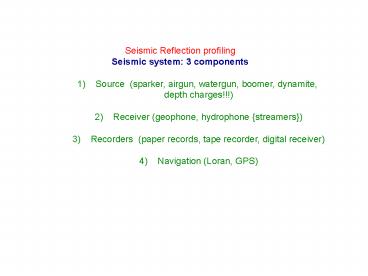Seismic Reflection profiling - PowerPoint PPT Presentation
1 / 18
Title:
Seismic Reflection profiling
Description:
... amplitude' reflectors-no change (or contrast) gives. no ... Multiples caused by 'ringing' inside two layers or high contrast boundaries 'peglegs'; 'Bowties' ... – PowerPoint PPT presentation
Number of Views:73
Avg rating:3.0/5.0
Title: Seismic Reflection profiling
1
- Seismic Reflection profiling
- Seismic system 3 components
- Source (sparker, airgun, watergun, boomer,
dynamite, - depth charges!!!)
- 2) Receiver (geophone, hydrophone streamers)
- 3) Recorders (paper records, tape recorder,
digital receiver) - 4) Navigation (Loran, GPS)
2
Basic principles 1) Sound waves reflect off
interfaces back to receiver 2) What interfaces
A) rocks or sediments have 2 properties of
significance for seismic reflection-
1-velocity (sonic)-speed that sound
travels through medium
2-saturated bulk density-function of grains and
porosity as well as density of
rock B) Product of two components - v
? is acoustic impedance
3
C) Amount of acoustic energy returned
is f (n) of rate of change of
impedance reflection coefficient
RC ?2v2 - ?1 v1
__________
?2v2 ?1 v1
Consequently
large changes in density or velocity should give
high amplitude reflectors-no change (or
contrast) gives no reflectors
4
Travel time and vertical exaggeration 2-way
travel time- sonic wave travels through a medium
at a certain velocity, which is a property of
that medium. Generally the denser the material,
the higher the velocity Seismic data is recorded
as a function of the time it takes for the sonic
wave to travel through the medium, reflect offan
interface and return to the receiver. This is
known as 2-way travel time. This can only be
converted to depth (i.e. metres) if the velocity
structure is known-e.g. For water this
equation is xseconds x 1500m/sec
________________
2 Vertical
exaggeration immense on seismic records
Vertical axis in time horizontal axis is in shot
number which is a function of ship speed and
firing rate
5
Artifacts
Multiples caused by
ringing inside two layers or high contrast
boundaries peglegs Bowties.
Details in the
handout from class Resolution
A
function of the wavelength (?) of the sound
wave-generally the resolution is half of the ? so
if the
wavelength is 1m then you can resolve a layer of
50cm. Descriptions
Continuity-
coherent/continuous incoherent/discontinuous
Amplitude- depends on density
contrasts between reflectors-if it is high then
you have a high amplitude
(strong) reflector
Frequency- generally frequency and ? are
related-high frequency is usually short ?
Relationships- stratigraphic principles
apply-use these relationships and echo traces to
interpret Interpretation
Produce isopach maps, combine in 3-D seismic
grids
6
System For shipboard use
7
(No Transcript)
8
(No Transcript)
9
(No Transcript)
10
(No Transcript)
11
Peg-legs and multiples
12
(No Transcript)
13
3-D seismic fence diagram
14
USGS Line 25 At least 4 DSDP/ ODP Legs Drilled
on This line
15
Raw seismic
Line 25-parallel To slope edge
Interpreted seismic
16
Line 25-across the slope
Raw seismic
Interpreted seismic
17
High resolution Huntec seismic from the Scotian
Shelf
Oldest Quaternary section
Seabed surface
Holocene boundary
18
Scotian Shelf section in 300m of water
Holocene sediments
Glacial sediments
Surface multiple

